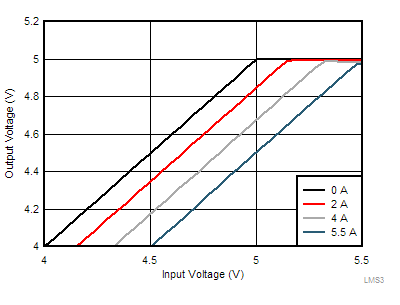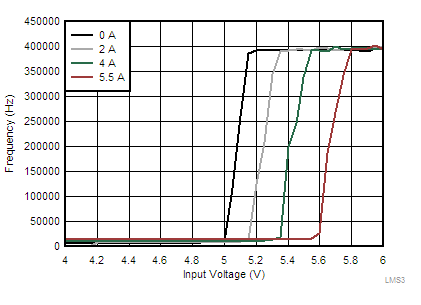ZHCSGY9B July 2017 – March 2018 LMS3655
PRODUCTION DATA.
- 1 特性
- 2 应用
- 3 说明
- 4 修订历史记录
- 5 Device Comparison Table
- 6 Pin Configuration and Functions
- 7 Specifications
- 8 Detailed Description
-
9 Application and Implementation
- 9.1 Application Information
- 9.2
Typical Applications
- 9.2.1 General Application
- 9.2.2 Adjustable 5-V Output
- 9.2.3 Adjustable 3.3-V Output
- 9.2.4 6-V Adjustable Output
- 9.3 Do's and Don't's
- 10Power Supply Recommendations
- 11Layout
- 12器件和文档支持
- 13机械、封装和可订购信息
8.4.3 Dropout
The minimum off time influences the dropout performance of the buck regulator. As the input voltage is reduced, to near the output voltage, the off time of the high-side switch starts to approach the minimum value (see Electrical Characteristics). Beyond this point the switching may become erratic or the output voltage falls out of regulation. To avoid this problem, the LMS3655 automatically reduces the switching frequency to increase the effective duty cycle. This results in two specifications regarding dropout voltage, as shown in System Characteristics. One specification indicates when the switching frequency drops to 330 kHz. The other specification indicates when the output voltage has fallen to 3% of nominal. See the Application Curves for typical dropout values. Figure 18 and Figure 19 show the overall dropout characteristic for the 5-V option. Additional dropout information is discussed in Application Curves for 5-V output and in Application Curves for 3.3-V output.
SPACE
 Figure 18. Overall Dropout Characteristics
Figure 18. Overall Dropout Characteristics
(VOUT = 5 V)
 Figure 19. Frequency Dropout Characteristics
Figure 19. Frequency Dropout Characteristics
(VOUT = 5 V)